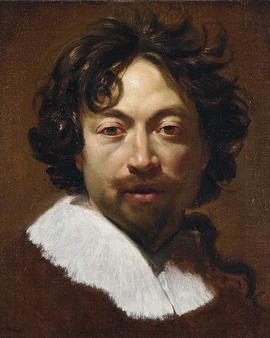Simon Vouet played an important role in French painting, as he introduced the Italian Baroque to the country. Vouet learned the basics of painting from his father Laurent Vouet. He soon became a well-known portrait painter. Already at the age of 14 he travelled to England for a commission. He finally travelled to Constantinople in 1611 in the wake of the Baron of Sancy. In the following year he continued his journey to Italy. Vouet developed his style during his stay in Italy between 1612 and 1627. Vouet was a natural academic talent. He quickly learned the Baroque style that was predominant in Italy at the time. Among other things he adopted Caravaggios dramatic play with light and shadow. The techniques of other great Italian masters like Paolo Veronese, Carracci, Guido Reni and Lanfranco also influenced his style. Vouet's fame grew rapidly and he became known beyond the borders of Italy. His probably most important commission in Rome was an altarpiece for St. Peter's Basilica, which is only preserved in fragments today.
His fame also caught the attention of King Louis XIII, who appointed Vouet as the first royal painter in 1627. Vouet therefore returned to France. For the next 15 years he dominated the French art scene and was able to get almost every major commission. He was not only responsible for portraits in the royal house. Vouet was commissioned to decorate various castles such as the Palais du Louvre, the Palais du Luxembourg and various other palaces. Before Vouet returned to France, the country lagged far behind Italy in its artistic development. This made him one of the most important French painters of the 18th century. In his studio Vouet trained the next generation of painters. His students included Charles le Brun, Valentin de Boulogne and his later sons in law Michel Dorigny and Francois Tortebat.
Simon Vouet's first marriage was to Virginia de Vezzo who was a famous and talented painter. She was also known for her beauty. Vouet therefore often took Virginia as a model for depictions of the Madonna or other holy women, in his religious works. The couple had 5 children. When Virginia died, Vouet remarried two years later. With his second wife he had 3 more children. One of his sons, Louis-René Vouet and his grandson Ludovico Dorigny also became painters. Despite his influence Vouet never found his way into the Académie Royale. This is said to have been due to his student le Brun, who was allegedly envious and jealous.
×





.jpg)
.jpg)
.jpg)
.jpg)
.jpg)
.jpg)
.jpg)
.jpg)
.jpg)
.jpg)
.jpg)
.jpg)
.jpg)
.jpg)
.jpg)
.jpg)
.jpg)
.jpg)
.jpg)
.jpg)
.jpg)
.jpg)
.jpg)
.jpg)
.jpg)
.jpg)
_Painting_by_Simon_Vouet_(1590-1649)_and_works_-_(MeisterDrucke-983819).jpg)
_Painting_by_Simon_Vouet_(1590-1649)_and_works_-_(MeisterDrucke-983819).jpg)
_-_1627_-_-_(MeisterDrucke-1325314).jpg)
_-_1627_-_-_(MeisterDrucke-1325314).jpg)
.jpg)
.jpg)
.jpg)
.jpg)
.jpg)
.jpg)
.jpg)
.jpg)
_17th_century_Sun_-_(MeisterDrucke-1002766).jpg)
_17th_century_Sun_-_(MeisterDrucke-1002766).jpg)
.jpg)
.jpg)
.jpg)
.jpg)
.jpg)
.jpg)
_Cimon_condamne_a_mourir_de_faim_en_prison_se_-_(MeisterDrucke-1324860).jpg)
_Cimon_condamne_a_mourir_de_faim_en_prison_se_-_(MeisterDrucke-1324860).jpg)
.jpg)
.jpg)
.jpg)
.jpg)
.jpg)
.jpg)
.jpg)
.jpg)
_-_(MeisterDrucke-1656390).jpg)
_-_(MeisterDrucke-1656390).jpg)
.jpg)
.jpg)
.jpg)
.jpg)
.jpg)
.jpg)
.jpg)
.jpg)
.jpg)
.jpg)
.jpg)
.jpg)
.jpg)
.jpg)
_-_(MeisterDrucke-1656273).jpg)
_-_(MeisterDrucke-1656273).jpg)
_(Allegoric_portrait_of_Anne_of_-_(MeisterDrucke-1314050).jpg)
_(Allegoric_portrait_of_Anne_of_-_(MeisterDrucke-1314050).jpg)
.jpg)
.jpg)
.jpg)
.jpg)
.jpg)
.jpg)
.jpg)
.jpg)
.jpg)
.jpg)
.jpg)
.jpg)
_1620_Sun_12x17_m_Ottawa_N_-_(MeisterDrucke-998972).jpg)
_1620_Sun_12x17_m_Ottawa_N_-_(MeisterDrucke-998972).jpg)
_Oil_on_ca_-_(MeisterDrucke-1011042).jpg)
_Oil_on_ca_-_(MeisterDrucke-1011042).jpg)
.jpg)
.jpg)
.jpg)
.jpg)
.jpg)
.jpg)
_-_(MeisterDrucke-1099318).jpg)
_-_(MeisterDrucke-1099318).jpg)
.jpg)
.jpg)
.jpg)
.jpg)
_-_(MeisterDrucke-1092467).jpg)
_-_(MeisterDrucke-1092467).jpg)
.jpg)
.jpg)
_-_(MeisterDrucke-1172254).jpg)
_-_(MeisterDrucke-1172254).jpg)
.jpg)
.jpg)
.jpg)
.jpg)
.jpg)
.jpg)
.jpg)
.jpg)
.jpg)
.jpg)
.jpg)
.jpg)
.jpg)
.jpg)
.jpg)
.jpg)
.jpg)
.jpg)
.jpg)
.jpg)
.jpg)
.jpg)
.jpg)
.jpg)
.jpg)
.jpg)
.jpg)
.jpg)
_-_(MeisterDrucke-1426206).jpg)
_-_(MeisterDrucke-1426206).jpg)
.jpg)
.jpg)
.jpg)
.jpg)
_Eveque_de_Paris_(7th_century)_delivating_the_pris_-_(MeisterDrucke-982595).jpg)
_Eveque_de_Paris_(7th_century)_delivating_the_pris_-_(MeisterDrucke-982595).jpg)
_1627_Sun_08x06_-_(MeisterDrucke-998967).jpg)
_1627_Sun_08x06_-_(MeisterDrucke-998967).jpg)
.jpg)
.jpg)
.jpg)
.jpg)
_1645_Sun_11_-_(MeisterDrucke-971973).jpg)
_1645_Sun_11_-_(MeisterDrucke-971973).jpg)
_17th_century_Sun_216x146_m_L_-_(MeisterDrucke-1002997).jpg)
_17th_century_Sun_216x146_m_L_-_(MeisterDrucke-1002997).jpg)
.jpg)
.jpg)
.jpg)
.jpg)
.jpg)
.jpg)
.jpg)
.jpg)
.jpg)
.jpg)
.jpg)
.jpg)
.jpg)
.jpg)
.jpg)
.jpg)
.jpg)
.jpg)
 - (MeisterDrucke-180819).jpg)
 - (MeisterDrucke-180819).jpg)
.jpg)
.jpg)
.jpg)
.jpg)
_Peinture_de_Simon_Vouet_(1590-1649)_Huile_sur_toile_82_x_100_c_-_(MeisterDrucke-1313651).jpg)
_Peinture_de_Simon_Vouet_(1590-1649)_Huile_sur_toile_82_x_100_c_-_(MeisterDrucke-1313651).jpg)
.jpg)
.jpg)
.jpg)
.jpg)
.jpg)
.jpg)
_-_(MeisterDrucke-1422615).jpg)
_-_(MeisterDrucke-1422615).jpg)
.jpg)
.jpg)
_-_(MeisterDrucke-1631872).jpg)
_-_(MeisterDrucke-1631872).jpg)
.jpg)
.jpg)
_1639_Grenoble_Mu_-_(MeisterDrucke-993725).jpg)
_1639_Grenoble_Mu_-_(MeisterDrucke-993725).jpg)
_Peinture_de_Simon_Vouet_(1590-1649)_Huil_-_(MeisterDrucke-1313403).jpg)
_Peinture_de_Simon_Vouet_(1590-1649)_Huil_-_(MeisterDrucke-1313403).jpg)






